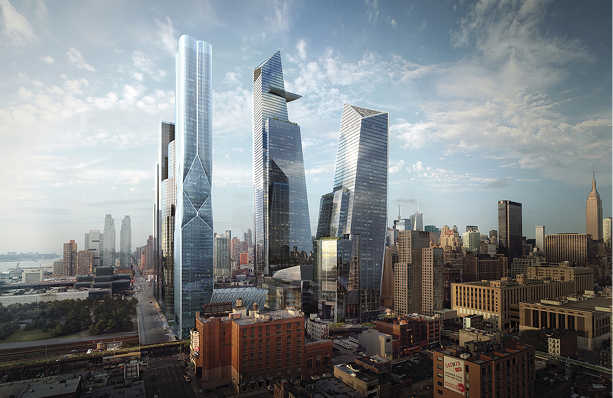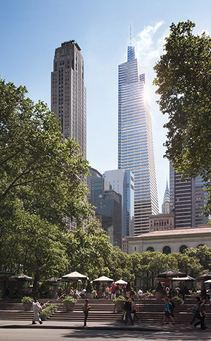


![]()
ONLINE

The Impact of
Architecture
Editors’ Note
In 1976, along with William Pedersen and Sheldon Fox, A. Eugene Kohn founded KPF with the commitment to providing design and management excellence matched with technical proficiency and superior client service. From the outset, KPF was founded with the goal of creating a firm that would continue beyond its founding partners – the three sought to give opportunities to talented young architects to help them become the next generation of leaders. Serving as Partner-in-Charge of many of KPF’s major domestic and international projects, Kohn, along with his original partners, shaped the firm into one of the world’s leaders in all aspects of architectural practice. Kohn earned B.A. and M.A. degrees from the University of Pennsylvania and served in the U.S. Navy on Active Duty for three years between degrees, for five years on Reserve Duty, and retired as a Lieutenant Commander. He is an Executive Fellow of the Graduate School of Design at Harvard University where he teaches, and he also teaches at the Harvard Business School. He helped establish the Harvard Real Estate Center Academic Initiative, is a founding member of the Wharton School Real Estate Center Advisory Board, and has served for 30 years on the Board of Overseers at PennDesign. Kohn was a trustee for the University of Pennsylvania and was honored with the 2010 Alumni Award of Merit by that University. This is the highest university-wide award presented to alumni. Kohn has also been recognized with the Wharton Real Estate Center’s Lifetime Achievement Award; the University of Pennsylvania – PennDesign Dean’s Medal of Achievement, the highest honor awarded by the institution; and the Ellis Island Medal of Honor. In 2013, Kohn was honored by Publicolor.
Company Brief
Operating as one firm with six global offices, KPF (kpf.com) is one of the world’s preeminent architecture firms with almost 700 staff members from 43 different countries who together speak more than 30 languages. The firm’s diverse portfolio comprises corporate, investment office buildings, hospitality, academic, medical, research, civic, museum, transportation, residential, and mixed-use projects, and includes more than 100 projects that are certified or pursuing green building certification.
Are you surprised to see the kind of development now taking place all over New York?
New York hasn’t seen this kind of growth in real estate for around 30 years.
Right now, all of the New York markets seem hot, particularly the residential market. Residential development seems to happen wherever there is a vacant site. The biggest change I see in New York right now is the high-end residential development, which has sparked super tall buildings from Midtown to lower Manhattan.
As architects, we enjoy the challenge of designing these elegant super-tall towers, almost pencil-like in their proportions. The smaller sites with smaller floorplates create narrow towers that rise from 60 to over 100 stories high. The most extreme of these buildings have floorplates of 4,000 square feet or less.

Hudson Yards rendering
The largest concentration of new office buildings seems to be in the Hudson Yards Redevelopment area. The portion over the LIRR tracks, which is being developed by The Related Companies, consists of over 17 million square feet of buildings containing a mix of uses. Among the many projects KPF is designing in Hudson Yards are three new office towers.
KPF is also designing a very tall tower for SL Green next to Grand Central called One Vanderbilt. The current stock of older office buildings in that area does not meet the needs of today’s modern corporations; therefore, there is a need for the new towers being proposed.
We are also working on the repositioning of existing buildings, including 280 Park Avenue in Midtown – making major improvements and creating more attractive and functional office buildings.
The recent boom in residential development is in part the result of investments by foreign companies and individuals in New York real estate. Such investments are a way to keep an investor’s money in a relatively safe haven and therefore encourage the extremely high prices being charged.
A potentially negative outcome of this type of tenant or owner is that the buildings become dark for most of the year, because as investment properties, they are not really occupied.
With so many new starts, the question is how deep the market is for this type of building. Should foreign investment slow down? Is there a large enough market of U.S. buyers to make these projects financially sound?

One Vanderbilt
Are you optimistic that the zoning changes, originally proposed by the Bloomberg administration, will be overcome and allow for development in Midtown?
Yes, one way or another, the original Midtown East Rezoning plan to increase density will be enacted by the current administration to allow for the development of taller, larger office buildings in the Grand Central area. A healthy city needs a strong business district – Midtown East is this hub for commuters and businesses; therefore, it is wise to maximize density in the area. Great cities need strong centers.
Increased density will be reflected in our project One Vanderbilt, adjacent to Grand Central. It is simply good urban planning to place such a large urban development adjacent to a major transportation hub. However, this building needs to be most sensitive to Grand Central, and its design will embrace the principles of “Terminal City,” upon which Grand Central was developed. It will provide a series of pedestrian connections at a variety of levels that connect to the Grand Central Concourse, subway lines, and the anticipated East Side Access Concourse. The design includes a public room and separate subway entry at grade that will provide public access to Grand Central at the base of the building. The project will also redefine the one block section of Vanderbilt Avenue between 42nd and 43rd as a pedestrian plaza. Finally, the building will pay respect to its location at the epicenter of the city’s skyline; taller than the Chrysler Building and about the same height as the Empire State Building, the tapered tower design, although modern in expression, pays homage to the classic New York City point towers.
Is it well understood that real estate is the backbone of the city and how critical is that understanding?
The real estate community physically crafts the city we live in, and is therefore crucial. Furthermore, building creates jobs in construction, and in future maintenance. New office buildings create appropriate space for businesses seeking to locate in Manhattan.
I always stress that the real estate community has a responsibility to citizens, for what is built affects us all. A new building or development should seek more than just financial value; it should seek creation of value for a city and its citizens in terms of quality of design and positive impact on a space.•